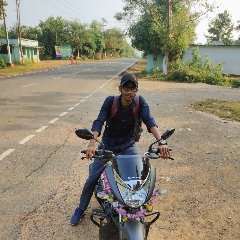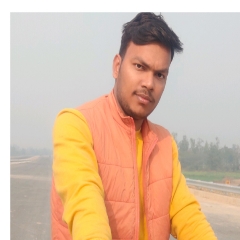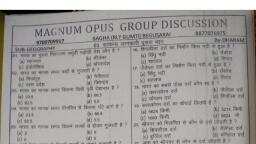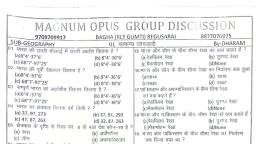Question 2 :
Match the following <table> <tr> <td> List-I (Wind type) </td> <td> List-II (Regions where they) </td> </tr> <tr> <td> A. Brick fielders </td> <td> 1. N. California </td> </tr> <tr> <td> B. Sirocco </td> <td> 2. Australia </td> </tr> <tr> <td> C. Bergs </td> <td> 3. Mediterranean </td> </tr> <tr> <td> D. Northers </td> <td> 4. Africa </td> </tr> </table>
Question 5 :
Which one of the following pairs of properties of typical air masses is correct?
Question 7 :
Consider the following statements:<table> <tr> <td> 1. Rajmahal highlands consist of lava flow deposits. </td> </tr> <tr> <td> 2. Bundelkhand gneiss belong to the oldest Archaean rocks of India. </td> </tr> </table> Which of the statements given above is/are correct?
Question 8 :
River Luni originates near Pushkar and drains into whit one of the following?
Question 9 :
Match the following two lists and choose the correct answer from the codes given below: <table> <tr> <td> List-I (Oceans) </td> <td> List-II (Ridges) </td> </tr> <tr> <td> A. Atlantic ocean </td> <td> 1. Cocos ridge </td> </tr> <tr> <td> B. Pacific ocean </td> <td> 2. Lomonosov ridge </td> </tr> <tr> <td> C. Indian ocean </td> <td> 3. Dolphin ridge and challenge ridge </td> </tr> <tr> <td> D. Arctic ocean </td> <td> 4. South East Indian ridge </td> </tr> </table>
Question 11 :
Consider the following statements with regard to cold waves in winter season in northern India:<table> <tr> <td> 1. There is lack of maritime influence. </td> </tr> <tr> <td> 2. Northern India is nearer to the Himalayan region. </td> </tr> <tr> <td> 3. Air mass comes from Polar Regions to northern India. </td> </tr> </table> Which of the statements given above is/are correct?
Question 12 :
The group of stars arranged in a definite pattern is called.
Question 15 :
Consider the following statements: <table> <tr> <td> 1. Either of the two belts over the oceans at about {tex}{{30}^{o}}{/tex}to{tex}{{35}^{o}}{/tex}N and S latitudes is known as Horse Latitude. </td> </tr> <tr> <td> 2. Horse latitude are low pressure belts. </td> </tr> </table> Which of the statements given above is/are correct?
Question 16 :
Consider the following statements:<table> <tr> <td> 1. Crystallization is a form of mechanical weathering. </td> </tr> <tr> <td> 2. Hydration causes granular disintegration. </td> </tr> <tr> <td> 3. Frost action is synonymous with freeze-thaw action. </td> </tr> </table> Which of the statements given above are correct?
Question 18 :
There are three distinct characters of temperature stratification of atmosphere around the Earth. Which one among the following is the correct arrangement of the layers (from the Earth's surface upwards?
Question 19 :
Given below are two statements, one labelled as Assertion and other labelled as Reason (R). Select your answer from the codes given below-<table> <tr> <td> Assertion: The Tarai region represents a marsh landscapes </td> </tr> <tr> <td> Reason: The Tarai region is a zone of seepage where the fine sand, silt and clay are deposited the emerging streams. </td> </tr> </table>
Question 20 :
Name the Continents that form a mirror image of each other
Question 22 :
Select the correct chronological order of the following geological periods, from the codes given below: <table> <tr> <td> 1. Oligocene </td> </tr> <tr> <td> 2. Eocene </td> </tr> <tr> <td> 3. Pliocene </td> </tr> <tr> <td> 4. Miocene </td> </tr> </table>
Question 26 :
Match the following: <table> <tr> <td> List-I (Mountain Types) </td> <td> List-II (Mountains) </td> </tr> <tr> <td> A. Block Mountain </td> <td> 1. Appalachian </td> </tr> <tr> <td> B. Old fold mountain </td> <td> 2. Rocky </td> </tr> <tr> <td> C. Young fold mountain </td> <td> 3. Black Forest </td> </tr> <tr> <td> D. Volcanic mountain </td> <td> 4. Socottish Highlands </td> </tr> <tr> <td> E. Relict mountain </td> <td> 5. Vesuvious </td> </tr> </table>
Question 27 :
Which among the following statements characterized EI Nino? <table> <tr> <td> I. It occurs at irregular intervals </td> </tr> <tr> <td> II. It carriers warmer water </td> </tr> <tr> <td> III. It carries less saline water </td> </tr> <tr> <td> IV. Its atmospheric equivalent is southern oscillation. </td> </tr> </table> Select the correct, answer using the code given below
Question 28 :
Match the following<table> <tr> <td> List-I (Hill Station) </td> <td> List-II (Location in Map) </td> </tr> <tr> <td> A. Dharamsala </td> <td rowspan="4"> <img style='object-fit:contain' src="https://storage.googleapis.com/teachmint/question_assets/RRB/5fa53a3eefcf451453e232cf"/> </td> </tr> <tr> <td> B. Almora </td> </tr> <tr> <td> C. Nainital </td> </tr> <tr> <td> D. Darjeeling </td> </tr> </table>
Question 29 :
Which of the following regions is NOT affected much by the Arabian Sea branch of Monsoon?
Question 31 :
Which one of the following is not associated with Monsoon climate in India?
Question 32 :
Amarkantak plateau in the Maikal hills marks the origin of the river
Question 34 :
The place located at the confluence of Alaknanda and Bhagirathi rivers is
Question 35 :
Match List-I with List-II and select the correct answer using die code given below the Lists:<table> <tr> <td> List-I (Lake) </td> <td> List-II (Type) </td> </tr> <tr> <td> A. Ashtamudi Kayal </td> <td> 1. Residual (sweet water) </td> </tr> <tr> <td> B. Himayat Sagar </td> <td> 2. Lagoon </td> </tr> <tr> <td> C. Dal Lake </td> <td> 3. Glacial </td> </tr> <tr> <td> D. Tsomgo Lake </td> <td> 4. Artificial (sweet water </td> </tr> </table>
Question 36 :
Examine the following statements and select the correct answer using the codes given below: <table> <tr> <td> 1. The atmospheric air is never completely dry. </td> </tr> <tr> <td> 2. Water vapour can occupy as much as 4 per cent of the atmospheric volume. </td> </tr> <tr> <td> 3. Water vapour in the atmosphere is always invisible. </td> </tr> </table>
Question 37 :
The factor that determines the water holding capacity of rock debris is its <table> <tr> <td> 1. porosity </td> </tr> <tr> <td> 2. structure </td> </tr> <tr> <td> 3. texture </td> </tr> <tr> <td> 4. permeability </td> </tr> </table>
Question 38 :
A study of the nature of the old sedimentary rocks gives an indication about the <table> <tr> <td> 1. age of the earth </td> </tr> <tr> <td> 2. past environmental conditions </td> </tr> <tr> <td> 3. old civilizations </td> </tr> <tr> <td> 4. direction of plate movements </td> </tr> </table>
Question 39 :
Consider the following statements <table> <tr> <td> 1. In the month of July, the Inter Tropical Convergence Zone is located in the Indo Gangetic plain. </td> </tr> <tr> <td> 2. Northen Inter Tropical Convergence Zone is the zone of clouds and heavy rainfall. </td> </tr> </table> Which of the statement given above is/are correct?
Question 41 :
DIRECTIONS: The following question consist of two statements, statement 1 and statement II. You are to examine the two statements carefully and select the answers to these items using the code given below.<table> <tr> <td> Statement I: Doldrums is a calm belt between {tex}{{5}^{o}}{/tex}N and {tex}{{5}^{o}}{/tex}S of the equation </td> </tr> <tr> <td> Statement II: The sun rays strike almost vertically over the equation throughout the year </td> </tr> </table>
Question 43 :
DIRECTIONS: The following question consist of two statements. Statement I and Statement II. You are to examine these two statements carefully and select the answers to this question using the code given the low:<table> <tr> <td> Statement I: The decrease of air temperature with increasing altitudes in the atmosphere is called the vertical temperature gradient. </td> </tr> <tr> <td> Statement II: In Troposphere, air temperature decreases with increasing altitude due to radiation from the Earth. </td> </tr> </table>
Question 44 :
Which one among the following sequences of water bodies, from lower to higher salinity concentration, is correct?
Question 45 :
Which one of the following places is not located on bank of river Ganga?
Question 46 :
The Panama Canal joins- <table> <tr> <td> I. Pacific Ocean </td> </tr> <tr> <td> II. Atlantic Ocean </td> </tr> <tr> <td> III. Columbia </td> </tr> <tr> <td> IV. Costa Rica </td> </tr> </table>
Question 47 :
The coral reefs that are generally: found attached to the shore with an intervening shallow channel or a lagoon is called-
Question 50 :
What is the other name of the highest range in the Western Ghats?





















































